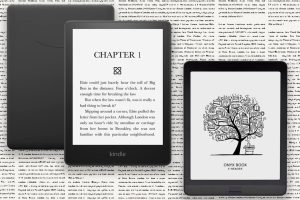eReaders: The Future of Reading
February 13, 2023
Reading is supposed to be time away from the screen, but with the introduction of e-readers like the Kindle and Nook, users turn to the screen to read, too.
The gratification that comes with turning pages in a physical book will never be replaced, however, reading on an e-reader comes with its own gratification, like watching the percentage of book completed gradually increase, or the time left in the chapter gradually decrease. The traditional flip of a page is mimicked by a refresh of the screen, though the reader never has to worry about a bookmark falling out or losing their place in the book.
With the Amazon Kindle, readers can start a book on their phone or tablet through the Kindle app, and pick up where they left off on the Kindle, making it easy for readers to read at home, or on the go. The device is slim, lightweight and fits easily in most bags, making it easy to travel with if needed.
With services like Kindle Unlimited, a monthly subscription service with a library of over two million books, and Libby, a free e-book service through most public libraries, readers can easily and affordably find most books at any time, making it even more convenient for travel. Instead of packing multiple books for a week-long trip, readers can download books to their e-reader, taking up no additional space but still allowing them to read multiple books while traveling.
Most e-readers also have built-in backlights, meaning users can read without a lamp or light on, minimizing distractions to others in the same room. The size of text, font, margins and line spacing can be adjusted, making it easier for readers to see when compared to a normal book. Batteries in e-readers stay charged for about 6-10 weeks at a time, meaning the battery won’t get in the way of finishing a book.
Despite all of the perks of an e-reader, it can’t replace a physical book. It won’t fill space on a shelf, have the same smell of paper, the same flip of the page, or the same color or detail, but with less cost per book, it’s a great option for readers on a budget or who travel often. eReaders are the future, and it’s time to put the paper books to rest.








